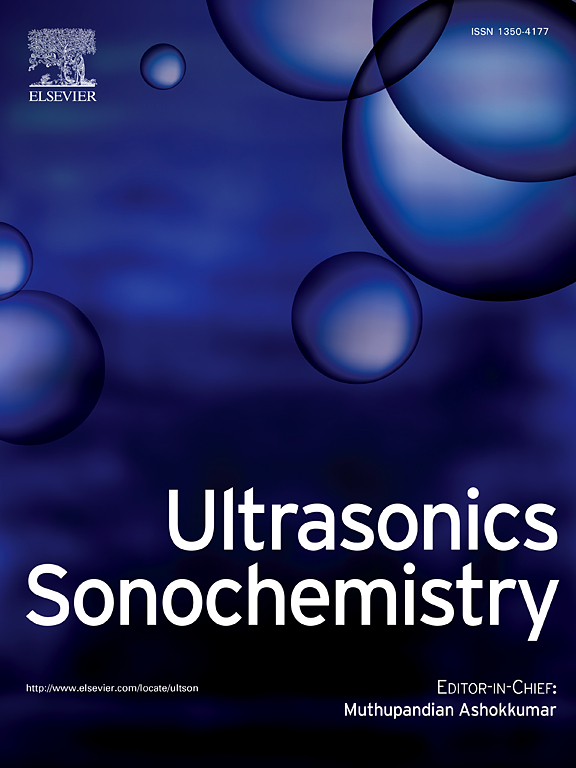Tuning synthesis and sonochemistry forges learning and enhances educational training: Protection of 1,3-diols under heterogeneous catalysis as sustainable case study
IF 8.7
1区 化学
Q1 ACOUSTICS
引用次数: 0
Abstract
This research article describes the thermal and sonochemical enhancements of 1,3-diol protection, via acetal formation, catalyzed by a biomass-derived heterogeneous catalyst. This investigation was also conducted under the framework of a postgraduate program in green chemistry, and the application of ultrasonic activation represented an opportunity to expose the field to junior colleagues unaware of sonochemistry. Accordingly, we show not only a facile and high-yielding synthetic transformation, but also the pluses of performing a parallel protocol using low-frequency ultrasound, which provided new learning tools and skills in context. The main role of sound waves can be associated to enhanced mass transfer of the heterogeneous reaction (false sonochemistry). Acoustic energy was delivered into the reagents and solvent using so-called cavitation intensifying bags (CIB). The micropitted polymeric material enabled a greater focused radiation that proved to be highly reproducible at 25 °C and led to reaction completion much faster than the conventional external heating. Furthermore, sonication fine-tunes selectivity in ketal formation, as witnessed by a facile synthesis of solketal, a green solvent obtained by acetalization of glycerol. The pedagogical benefits of conveying education in sonochemistry are outlined, alongside the catalyst characterization of the ultrasound-driven reaction. Our ambition is to stimulate similar pursuits in synthesis and catalysis at other laboratories and educational institutions.

调谐合成和声化学促进学习和加强教育培训:在多相催化下保护1,3-二醇作为可持续的案例研究
本文描述了一种生物质衍生的非均相催化剂通过缩醛形成对1,3-二醇保护的热和声化学增强作用。这项调查也是在绿色化学研究生课程的框架下进行的,超声波激活的应用为不了解超声化学的初级同事提供了一个机会。因此,我们不仅展示了一个简单而高产的合成转化,而且还展示了使用低频超声执行并行协议的优点,它提供了新的学习工具和技能。声波的主要作用是增强非均相反应的传质(假声化学)。利用所谓的空化强化袋(CIB)将声能传递到试剂和溶剂中。微孔聚合物材料能够产生更大的聚焦辐射,在25°C下具有很高的可重复性,并且比传统的外部加热更快地完成反应。此外,超声微调了缩醛形成的选择性,这一点可以从索酮(一种由甘油缩醛化得到的绿色溶剂)的简单合成中得到证明。本文概述了超声化学教学的益处,以及超声驱动反应的催化剂表征。我们的目标是激发其他实验室和教育机构在合成和催化方面的类似追求。
本文章由计算机程序翻译,如有差异,请以英文原文为准。
求助全文
约1分钟内获得全文
求助全文
来源期刊

Ultrasonics Sonochemistry
化学-化学综合
CiteScore
15.80
自引率
11.90%
发文量
361
审稿时长
59 days
期刊介绍:
Ultrasonics Sonochemistry stands as a premier international journal dedicated to the publication of high-quality research articles primarily focusing on chemical reactions and reactors induced by ultrasonic waves, known as sonochemistry. Beyond chemical reactions, the journal also welcomes contributions related to cavitation-induced events and processing, including sonoluminescence, and the transformation of materials on chemical, physical, and biological levels.
Since its inception in 1994, Ultrasonics Sonochemistry has consistently maintained a top ranking in the "Acoustics" category, reflecting its esteemed reputation in the field. The journal publishes exceptional papers covering various areas of ultrasonics and sonochemistry. Its contributions are highly regarded by both academia and industry stakeholders, demonstrating its relevance and impact in advancing research and innovation.
 求助内容:
求助内容: 应助结果提醒方式:
应助结果提醒方式:


